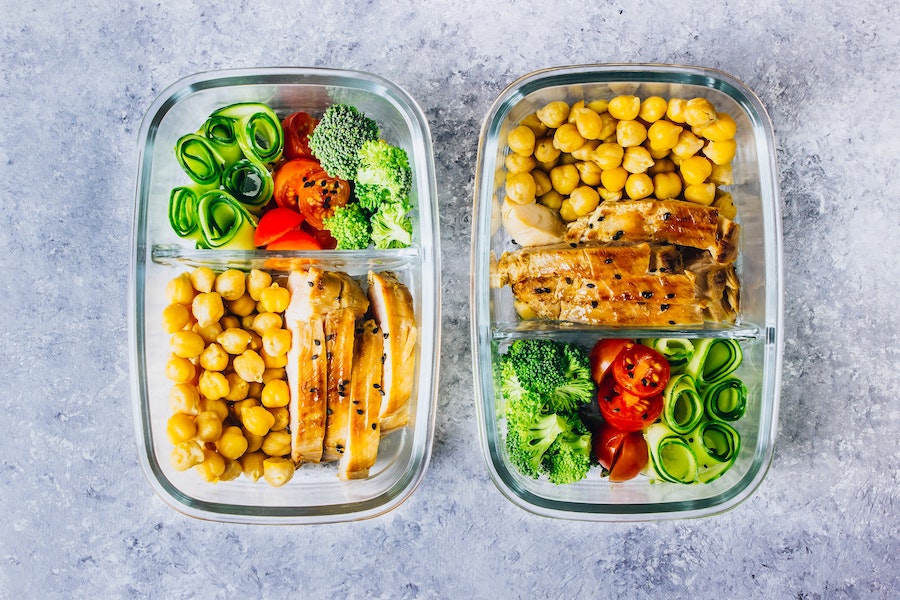7 meal prep tips that will make January so much easier
Check out the hashtag #mealprep on Instagram and one thing is obvious, being organised with your food choices has basically become a whole subculture, with its own micro trends and influencers.
Meal prepping shouldn’t be intimidating though, and you don’t need to cook overly complicated or experimental dishes to get in on the game.
A good meal prepping strategy should save you both time and money, as having your meals laid out for the week means you won’t be tempted to splurge all your cash on expensive, or unhealthy, convenience foods while you’re out and about.
With these few simple hacks, you can ace your forthcoming dinners and spend your evenings watching Netflix instead…
1. Prep your breakfast the night before
If you’re someone that often skips breakfast because you don’t have time in the mornings, prep your brekkie the night before so you don’t have an excuse to go to Starbucks.
An easy, make-ahead breakfast could be a hearty serving of overnight oats that you can pack up into a mason jar and enjoy at your desk. Having some homemade granola bars in your cupboard is a great grab-and-go option that can stop you from snacking on sugary muffins and croissants too.
2. Pre-cook your grains and pulses for the week
Cooking a few portions of grains on a Sunday afternoon means you can easily put together salads without having to slave over a pan during the week.
Great options include brown basmati rice, quinoa and lentils. Simply divide up the portions into containers, chuck them in the fridge and revisit them when you need a base for your meals (most will last around three to four days in the fridge).
Freezing your grains means they’ll last a lot longer (around two months) and they’re very simple to defrost. All you have to do is put the plastic freezer bag filled with the grains into a bowl of hot water for 15 minutes, and you’re good to go.
3. Get yourself a spreadsheet or planner
Preparation is key. A simple spreadsheet can help you to map out all of your meals for the week, so you can see exactly what you need to cook ahead of time.
It’s also a good way to make sure your meals are nutritionally balanced, and that you’re always hitting your five-a-day. If you’re not sure where to start, there are lots of free templates online that can help keep you organised.
4. Chop your veggies in advance
Whether you like to roast a bunch of them as a healthy side dish, or you’re going to mix them with other ingredients to form a stir fry or soup, you can save yourself loads of time by chopping vegetables in advance.
Onions, mushrooms, peppers, butternut squash, sweet potato and courgettes can all be pre-chopped and chucked into containers for later in the week. To prevent them drying out in the frige, put a damp paper towel on top of the cut vegetables and store them in an airtight container.
5. Invest in the right equipment
If you’re prepping your lunches and dinner for the whole week, make sure you’ve got enough containers so you can store all your foods safely in the fridge. We suggest opting for glass or BPA-free plastic versions with airtight seals, to prevent foods from spoiling early.
6. Frozen veggies are your friends
If you often avoid the frozen foods aisle in the supermarket, you’re making a major food prep mistake.
Because they’re frozen at peak freshness, frozen vegetables generally contain more nutrients than fresh ones, which can lose a lot of their goodness during the ripening process. They can also sit in your freezer for months without going bad, so there’s less waste and no pressure to use them up straightaway.
Frozen veg converts swear by the fact there’s no chopping or peeling involved too, and in most cases, all you need to do is pop them in the microwave, or a pan of water, and they’re ready to go.
7. Make big batches of homemade sauces
Sauces can be one of the most arduous things to cook. The longer they stew, the better they taste, but who has time to whip up a new sauce every night?
Cooking a few staple sauces that you can grab and use when you’re tired in the week, is a great time-saving exercise.
Tomato sauce – with onions, chilli and garlic – is a fail-safe and can be used as a pizza topping, a dip for chopped veggies, or a thick sauce for a fresh lasagne. Creating your own – rather than relying on store bought jar sauces – means you cut out any added sugars and salt too.
Pesto is also super versatile and can be stirred into pasta or spread onto a sandwich. A fresh pesto sauce will last in the fridge for around three days, but you can also put the mixture (without Parmesan) into an ice cube tray and freeze into mini portions.
To defrost, simply pop one of the cubes onto a plate and leave to thaw at room temperature for 20 minutes. Then you can go back and add the Parmesan.
The Press Association
Latest posts by The Press Association (see all)
- The Osmonds star and ‘beloved husband and father’ Wayne Osmond dies aged 73 - January 2, 2025
- What screenings are available on the NHS to detect cancer early? - January 2, 2025
- Help your grandchildren make the most of Big Schools’ Birdwatch - January 1, 2025
- Veteran radio star Johnnie Walker dies aged 79 - December 31, 2024
- 5 fantastic winter walks for wildlife spotting - December 31, 2024




















